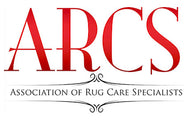Tufted Rugs

One of the more popular types of new rugs sold today are tufted rugs. Tufted rugs can be made by a machine in a factory or by a person using a hand held tufting gun. When a tufted rug is made, the face yarns are poked through but not wrapped around a primary backing. After that a layer of latex is spread across the back of the rug to strengthen and stiffen the construction of the rug and hold the face yarns in place. Finally a secondary backing cloth is added, both to protect the primary backing and for cosmetic reasons.
Machine tufted rugs are primarily made in The United States and are often referred to as broadloom and sold as wall to wall carpet or as area rugs. Hand tufted rugs are made primarily in Asia, usually in India or China, are sold as area rugs in a full variety of sizes and are sold by a variety of vendors , from specialty rug shops to home furnishing stores and websites. The primary benefits of this kind of construction are that the rugs are relatively inexpensive compared to traditional hand-knotted and hand-woven rugs, and they are faster to make compared to traditionally made rugs so they are more responsive to fashion trends. However, this type of construction has disadvantages as well.
From the moment the latex is applied to the rug, it begins to break down. Over time the secondary backing loses its “grip” or adhesion to the latex and bubbles and ripples can begin to show on the rug. If low quality latex was used, this can happen shortly after the rug was purchased. As latex ages it turns to a fine sand-like powder that is left on the floor underneath and near these rugs. Consumers often think sand is coming out of their rug but it is actually the latex in their rug breaking down. Odor can also be an issue with these rugs. Latex can give off a noxious odor that can vary from barely noticeable to oppressive depending on the quality of the adhesive. Rugs give off this odor before they are purchased, but often they are more noticeable in the smaller spaces of a home than in a large showroom.
Humid environments and warm rooms with sun exposure can also make the latex odor more noticeable. Additionally, in hand tufted rugs, the pattern is often stenciled onto the primary backing in a color that is unrelated to the rugs colors, and this stenciling can wick to the surface of the rug, marring it’s appearance. These issues make cleaning these rugs, especially hand tufted rugs, challenging. Some of these issues can be corrected. If the latex has failed, it may be possible to remove the secondary ling and rebuild the layer of latex, and if the stenciling wicks to the surface it can sometimes be removed with color strippers. However some issues cannot be corrected.
The odor given off by the latex used in the backing will not dissipate with cleaning and can even get worse. It is important to understand that these conditions are inherent in rugs of this construction and while your rug cleaning professional can use industry best practices in the cleaning of these rugs, they often cannot avoid, or undo these issues. A conversation with your rug care professional before cleaning about what can cannot be done for your rug is the best way to make sure you are satisfied with the results.




